2023 HYUNDAI TUCSON HYBRID wheel alignment
[x] Cancel search: wheel alignmentPage 589 of 699

Driver Assistance System7-160
Limitations of Remote Smart Parking
Assist
In the following circumstances, Remote
Smart Parking Assist performance to
park or exit the vehicle may be limited,
there may be a risk of collision, or
Remote Smart Parking Assist may turn
off. Park or exit the vehicle manually if
necessary.
• An object is attached to the steering wheel
• The vehicle is installed with a snow chain, spare tire or different size
wheel
• Tire pressure is lower or higher than the standard tire pressure
• Your vehicle is loaded with cargo longer or wider than your vehicle or a
trailer is connected to your vehicle
• There is a problem with the wheel alignment
• Your vehicle is leaned severely to one side
• Your vehicle is equipped with a trailer hitch
• The license plate is installed differently from the original location
• There is a person, animal or object above or below the ultrasonic sensor
when Remote Smart Parking Assist is
activated
• The parking space is curved or diagonal
• There is an obstacle such as a person, animal or object (trash can, bicycle,
motorcycle, shopping cart, narrow
pillar etc.) near the parking space • There is a circular pillar or narrow
pillar, or a pillar surrounded by objects
such as fire extinguisher, etc. near the
parking space
• The road surface is bumpy (curbstone, speed bump, etc.)
• The road is slippery
• The parking space is near a vehicle with higher ground clearance or big,
such as a truck, etc.
• The parking space is Inclined
• There is heavy wind
• Operating Remote Smart Parking Assist on uneven roads, gravel roads,
bushes, etc.
• The performance of the ultrasonic sensor is affected by extremely hot or
cold weather
• The ultrasonic sensor is covered with snow or water
• An object that generates ultrasonic waves is nearby
• A wireless device with a transmission function operates near the ultrasonic
sensors
• Your vehicle is affected by another vehicle’s Parking Distance Warning
• The sensor is mounted or positioned incorrectly by an impact to the
bumper
• When the ultrasonic sensor cannot detect the following objects:
- Sharp or slim objects, such as ropes,
chains or small poles
- Objects smaller than 10 in. (100 cm) in length and narrower than 6 in. (14
cm) in diameter
- Objects which tend to absorb sensor frequency, such as clothes,
spongy material or snow
Page 592 of 699
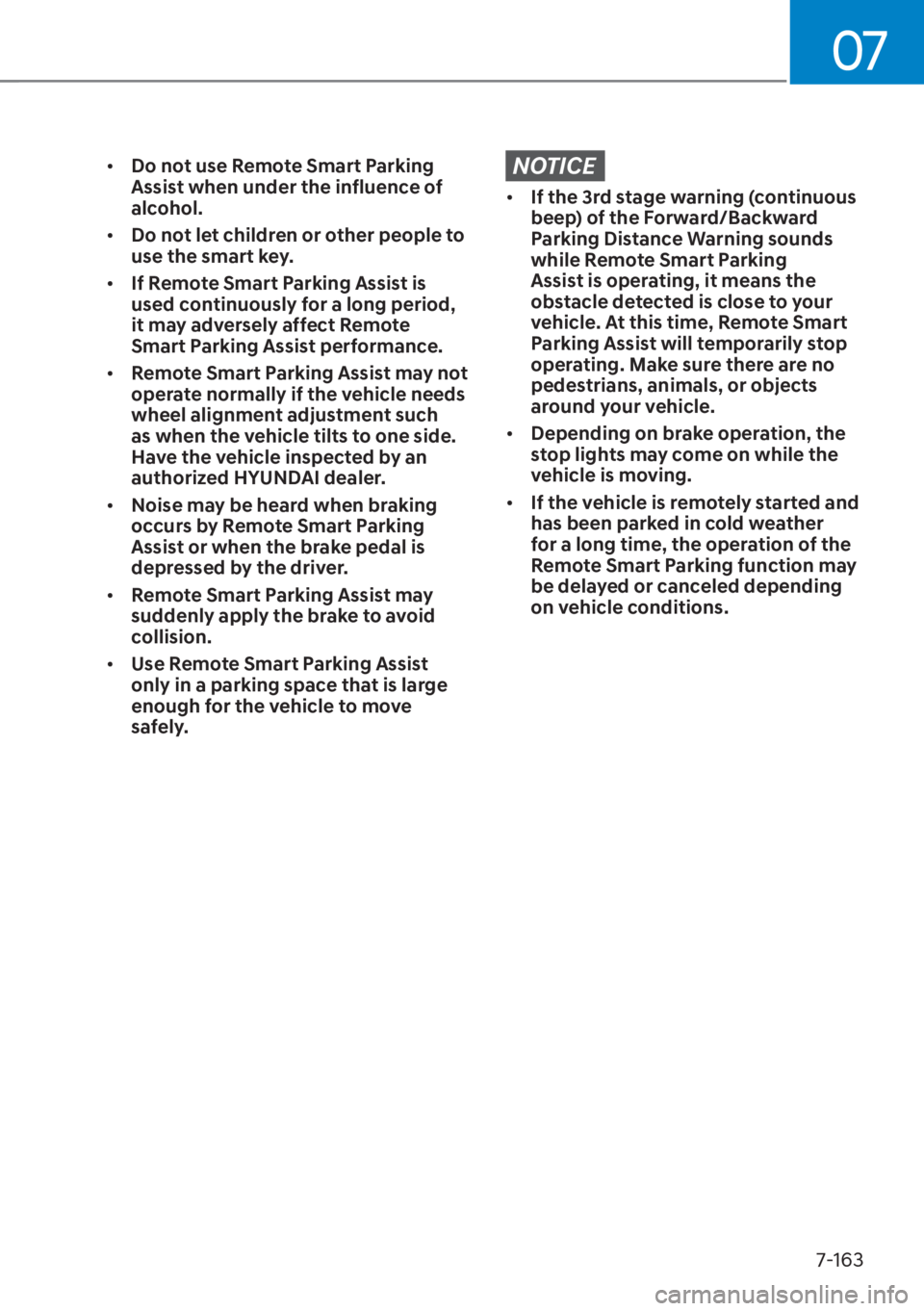
07
7-163
• Do not use Remote Smart Parking
Assist when under the influence of
alcohol.
• Do not let children or other people to
use the smart key.
• If Remote Smart Parking Assist is
used continuously for a long period,
it may adversely affect Remote
Smart Parking Assist performance.
• Remote Smart Parking Assist may not
operate normally if the vehicle needs
wheel alignment adjustment such
as when the vehicle tilts to one side.
Have the vehicle inspected by an
authorized HYUNDAI dealer.
• Noise may be heard when braking
occurs by Remote Smart Parking
Assist or when the brake pedal is
depressed by the driver.
• Remote Smart Parking Assist may
suddenly apply the brake to avoid
collision.
• Use Remote Smart Parking Assist
only in a parking space that is large
enough for the vehicle to move
safely. NOTICE
• If the 3rd stage warning (continuous
beep) of the Forward/Backward
Parking Distance Warning sounds
while Remote Smart Parking
Assist is operating, it means the
obstacle detected is close to your
vehicle. At this time, Remote Smart
Parking Assist will temporarily stop
operating. Make sure there are no
pedestrians, animals, or objects
around your vehicle.
• Depending on brake operation, the
stop lights may come on while the
vehicle is moving.
• If the vehicle is remotely started and
has been parked in cold weather
for a long time, the operation of the
Remote Smart Parking function may
be delayed or canceled depending
on vehicle conditions.
Page 624 of 699

9
Tires and Wheels ........................................................................\
..................... 9-34Tire Care ........................................................................\
..............................................9-34
Recommended Cold Tire Inflation Pressures ...........................................................9-34
Check Tire Inflation Pressure ........................................................................\
.............9-35
Tire Rotation ........................................................................\
.......................................9-36
Wheel Alignment and Tire Balance ........................................................................\
... 9-37
Tire Replacement ........................................................................\
............................... 9-37
Wheel Replacement ........................................................................\
.......................... 9-38
Tire Traction ........................................................................\
....................................... 9-38
Tire Maintenance..................................................................\
..................................... 9-38
Tire Sidewall Labeling ........................................................................\
........................9-39
Tire Terminology and Definitions ........................................................................\
.... 9-42
All Season Tires ........................................................................\
.................................. 9-44
Summer Tires ........................................................................\
.................................... 9-44
Snow Tires......................................................................\
............................................ 9-44
Radial-Ply Tires ........................................................................\
.................................. 9-45
Low Aspect Ratio Tires ........................................................................\
...................... 9-45
Fuses ...................................................................\
............................................. 9-47Instrument Panel Fuse Replacement ....................................................................... 9-48
Engine Compartment Panel Fuse Replacement ..................................................... 9-49
Fuse/Relay Panel Description........................................................................\
........... 9-50
Light Bulbs ........................................................................\
............................... 9-59Headlight, Position Lamp, Turn Signal Lamp, Daytime Running Light (DRL)
Replacement .............................................................\
................................................ 9-60
Side Repeater Lamp Replacement ........................................................................\
.. 9-60
Rear Combination Lamp Replacement .................................................................... 9-61
High Mounted Stop Lamp Replacement ................................................................. 9-64
License Plate Lamp Replacement ........................................................................\
.... 9-64
Interior Light Replacement ........................................................................\
............... 9-65
Appearance Care ........................................................................\
.................... 9-67Exterior Care ........................................................................\
.......................................9-67
Interior Care ........................................................................\
.........................................9-71
Emission Control System ........................................................................\
.........9-74
California Perchlorate Notice ........................................................................\
..9-77
Page 628 of 699
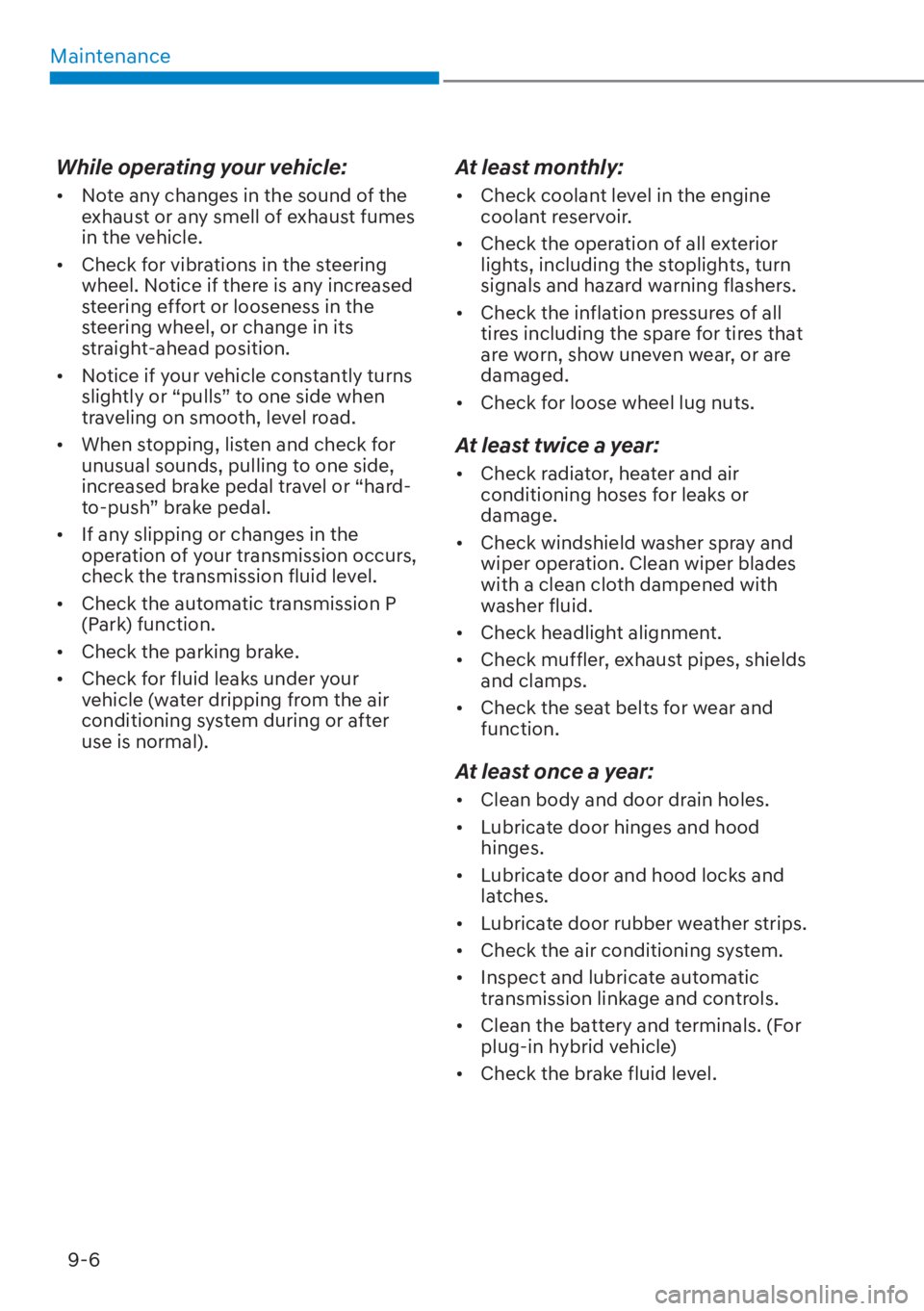
Maintenance9-6
While operating your vehicle:
• Note any changes in the sound of the exhaust or any smell of exhaust fumes
in the vehicle.
• Check for vibrations in the steering wheel. Notice if there is any increased
steering effort or looseness in the
steering wheel, or change in its
straight-ahead position.
• Notice if your vehicle constantly turns slightly or “pulls” to one side when
traveling on smooth, level road.
• When stopping, listen and check for unusual sounds, pulling to one side,
increased brake pedal travel or “hard-
to-push” brake pedal.
• If any slipping or changes in the operation of your transmission occurs,
check the transmission fluid level.
• Check the automatic transmission P (Park) function.
• Check the parking brake.
• Check for fluid leaks under your vehicle (water dripping from the air
conditioning system during or after
use is normal).
At least monthly:
• Check coolant level in the engine coolant reservoir.
• Check the operation of all exterior lights, including the stoplights, turn
signals and hazard warning flashers.
• Check the inflation pressures of all tires including the spare for tires that
are worn, show uneven wear, or are
damaged.
• Check for loose wheel lug nuts.
At least twice a year:
• Check radiator, heater and air conditioning hoses for leaks or
damage.
• Check windshield washer spray and wiper operation. Clean wiper blades
with a clean cloth dampened with
washer fluid.
• Check headlight alignment.
• Check muffler, exhaust pipes, shields and clamps.
• Check the seat belts for wear and function.
At least once a year:
• Clean body and door drain holes.
• Lubricate door hinges and hood hinges.
• Lubricate door and hood locks and latches.
• Lubricate door rubber weather strips.
• Check the air conditioning system.
• Inspect and lubricate automatic transmission linkage and controls.
• Clean the battery and terminals. (For plug-in hybrid vehicle)
• Check the brake fluid level.
Page 658 of 699
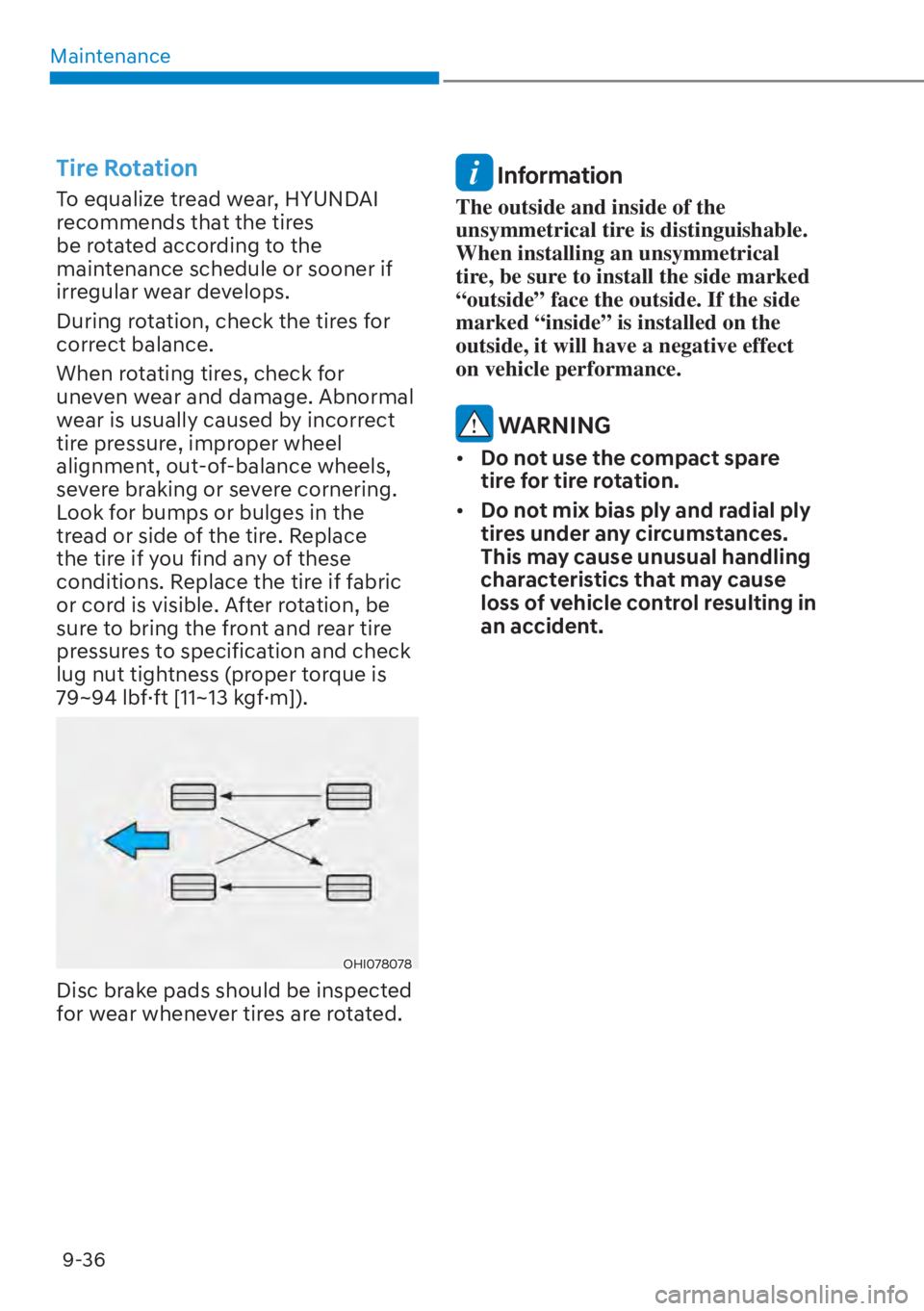
Maintenance9-36
Tire Rotation
To equalize tread wear, HYUNDAI
recommends that the tires
be rotated according to the
maintenance schedule or sooner if
irregular wear develops.
During rotation, check the tires for
correct balance.
When rotating tires, check for
uneven wear and damage. Abnormal
wear is usually caused by incorrect
tire pressure, improper wheel
alignment, out-of-balance wheels,
severe braking or severe cornering.
Look for bumps or bulges in the
tread or side of the tire. Replace
the tire if you find any of these
conditions. Replace the tire if fabric
or cord is visible. After rotation, be
sure to bring the front and rear tire
pressures to specification and check
lug nut tightness (proper torque is
79~94 lbf·ft [11~13 kgf·m]).
OHI078078OHI078078
Disc brake pads should be inspected
for wear whenever tires are rotated.
Information
The outside and inside of the
unsymmetrical tire is distinguishable.
When installing an unsymmetrical
tire, be sure to install the side marked
“outside” face the outside. If the side
marked “inside” is installed on the
outside, it will have a negative effect
on vehicle performance.
WARNING
• Do not use the compact spare
tire for tire rotation.
• Do not mix bias ply and radial ply
tires under any circumstances.
This may cause unusual handling
characteristics that may cause
loss of vehicle control resulting in
an accident.
Page 659 of 699
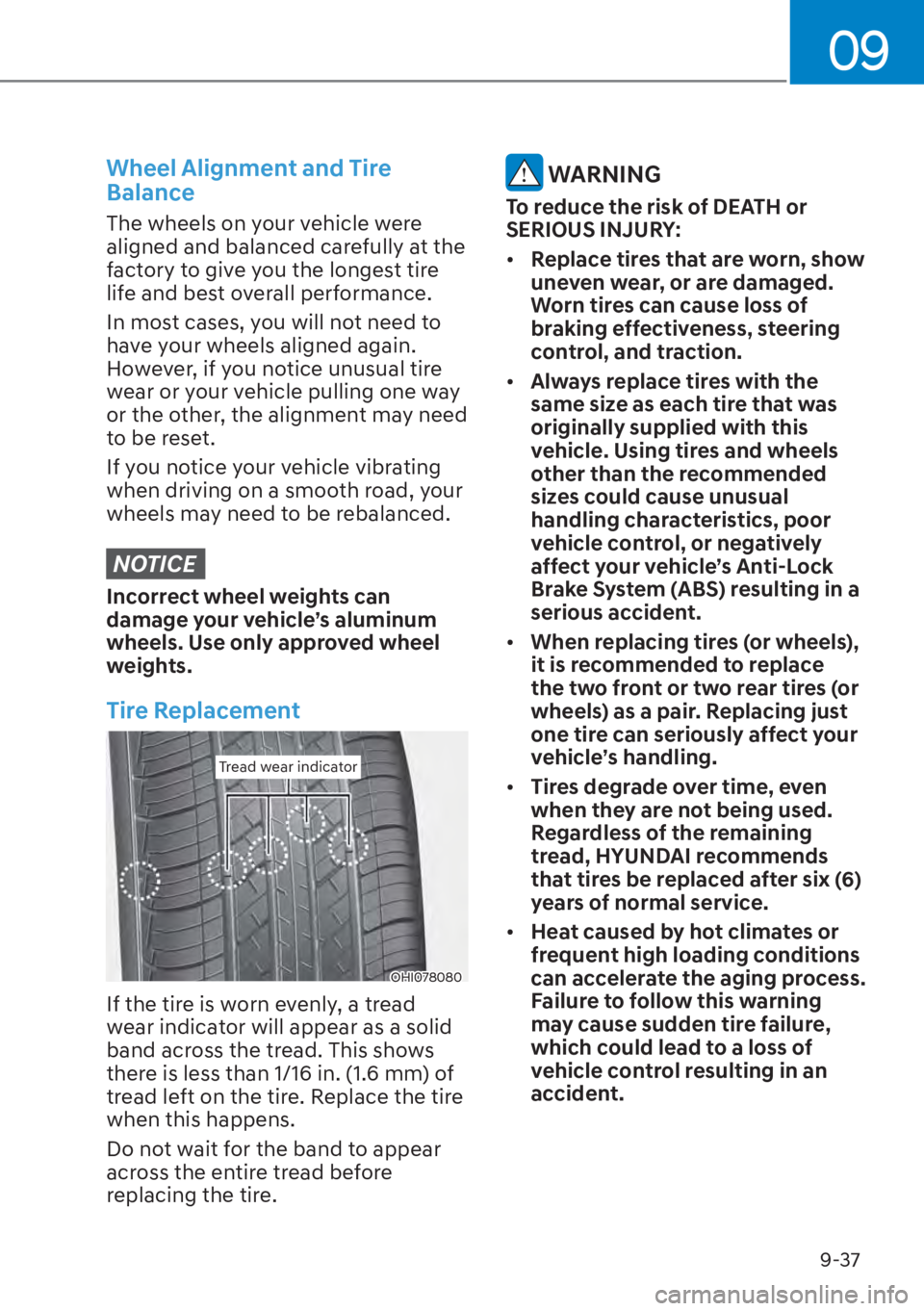
09
9-37
Wheel Alignment and Tire
Balance
The wheels on your vehicle were
aligned and balanced carefully at the
factory to give you the longest tire
life and best overall performance.
In most cases, you will not need to
have your wheels aligned again.
However, if you notice unusual tire
wear or your vehicle pulling one way
or the other, the alignment may need
to be reset.
If you notice your vehicle vibrating
when driving on a smooth road, your
wheels may need to be rebalanced.
NOTICE
Incorrect wheel weights can
damage your vehicle’s aluminum
wheels. Use only approved wheel
weights.
Tire Replacement
Tread wear indicatorTread wear indicator
OHI078080OHI078080
If the tire is worn evenly, a tread
wear indicator will appear as a solid
band across the tread. This shows
there is less than 1/16 in. (1.6 mm) of
tread left on the tire. Replace the tire
when this happens.
Do not wait for the band to appear
across the entire tread before
replacing the tire.
WARNING
To reduce the risk of DEATH or
SERIOUS INJURY:
• Replace tires that are worn, show
uneven wear, or are damaged.
Worn tires can cause loss of
braking effectiveness, steering
control, and traction.
• Always replace tires with the
same size as each tire that was
originally supplied with this
vehicle. Using tires and wheels
other than the recommended
sizes could cause unusual
handling characteristics, poor
vehicle control, or negatively
affect your vehicle’s Anti-Lock
Brake System (ABS) resulting in a
serious accident.
• When replacing tires (or wheels),
it is recommended to replace
the two front or two rear tires (or
wheels) as a pair. Replacing just
one tire can seriously affect your
vehicle’s handling.
• Tires degrade over time, even
when they are not being used.
Regardless of the remaining
tread, HYUNDAI recommends
that tires be replaced after six (6)
years of normal service.
• Heat caused by hot climates or
frequent high loading conditions
can accelerate the aging process.
Failure to follow this warning
may cause sudden tire failure,
which could lead to a loss of
vehicle control resulting in an
accident.
Page 660 of 699
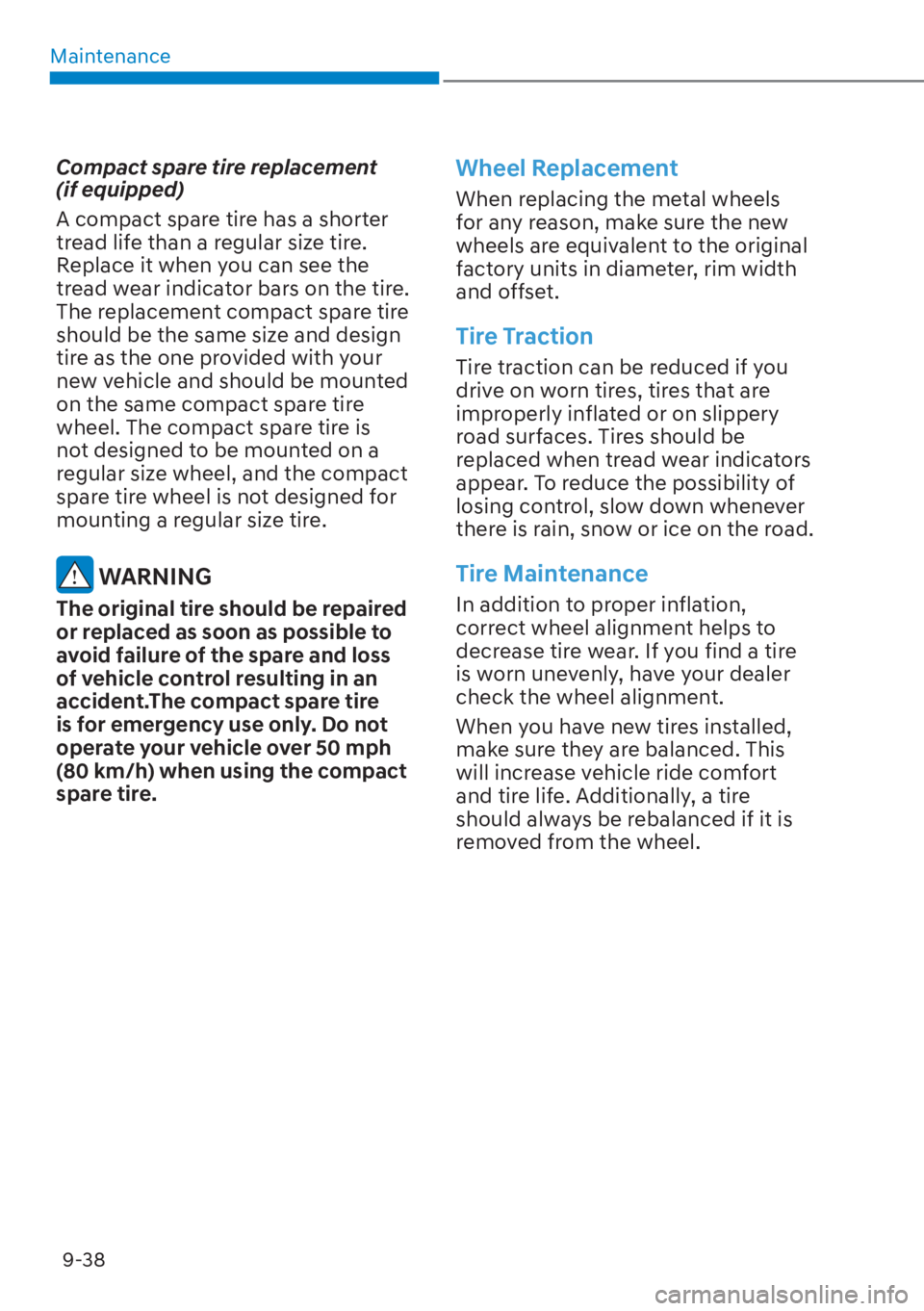
Maintenance9-38
Compact spare tire replacement
(if equipped)
A compact spare tire has a shorter
tread life than a regular size tire.
Replace it when you can see the
tread wear indicator bars on the tire.
The replacement compact spare tire
should be the same size and design
tire as the one provided with your
new vehicle and should be mounted
on the same compact spare tire
wheel. The compact spare tire is
not designed to be mounted on a
regular size wheel, and the compact
spare tire wheel is not designed for
mounting a regular size tire.
WARNING
The original tire should be repaired
or replaced as soon as possible to
avoid failure of the spare and loss
of vehicle control resulting in an
accident.The compact spare tire
is for emergency use only. Do not
operate your vehicle over 50 mph
(80 km/h) when using the compact
spare tire.
Wheel Replacement
When replacing the metal wheels
for any reason, make sure the new
wheels are equivalent to the original
factory units in diameter, rim width
and offset.
Tire Traction
Tire traction can be reduced if you
drive on worn tires, tires that are
improperly inflated or on slippery
road surfaces. Tires should be
replaced when tread wear indicators
appear. To reduce the possibility of
losing control, slow down whenever
there is rain, snow or ice on the road.
Tire Maintenance
In addition to proper inflation,
correct wheel alignment helps to
decrease tire wear. If you find a tire
is worn unevenly, have your dealer
check the wheel alignment.
When you have new tires installed,
make sure they are balanced. This
will increase vehicle ride comfort
and tire life. Additionally, a tire
should always be rebalanced if it is
removed from the wheel.